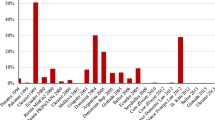Abstract
During the last decade, there has been a significant bias towards bond financing on emerging markets, with private investors relying on a bail-out of bonds by the international community. This bias has been a main cause of the recent excessive fragility of international capital markets. The following paper shows how collective action clauses in bonds contracts help to involve the private sector in risk-sharing. It argues that such clauses, as a market-based instrument, will raise the spreads for emerging market debt and so help to correct a market failure towards excessive bond finance. Recent pressure by the IMF to involve the private sector faces a conflict between the principle of honouring existing contracts and that of equal treatment of bondholders.
Similar content being viewed by others
References
Stanley Fischer: Learning the Lessons of Financial Crises: The Roles of the Public and Private Sectors, IMF, Washington 1999.
IMF: The International Capital Markets Report 1999, p 103.
Cf. also Bank for International Settlements (BIS): International Banking and Financial Market Development, BIS Quarterly Review, February 2000.
Barry Eichengreen: Toward a New International Financial Architecture: A Practical Post Asia Agenda, Institute for International Economics, Washington DC 1999.
IMF: Involving the Private Sector in Forestalling and Resolving Financial Crises, Washington 1999.
Council on Foreign Relations: Safeguarding Prosperity in a Global Financial System: The Future International Financial Architecture, Institute for International Economics, Washington DC 1999.
Emerging Markets Traders Association (EMTA): Is Burden-Sharing Being Pushed Too Far?, Position Paper 1999.
David Folkerts-Landau, Peter Garber: The New Architecture in Official Doctrine, Deutsche Bank, Global Markets, April 1999, pp. 1–16.
Cf. Barry Eichengreen, op. cit., Toward a New International Financial Architecture: A Practical Post Asia Agenda, Institute for International Economics, Washington DC 1999. p, 68; Andy Haldane: Private Sector Involvement in Financial Crisis: Analytics and Public Policy Approaches, in: Bank of England: Financial Stability Review, 1999, pp. 184–202, here p.196; and Stanley Fischer, op. cit. Learning the Lessons of Financial Crises: The Roles of the Public and Private Sectors, IMF, Washington 1999.
For an extensive study see IMF, op.cit. Involving the Private Sector in Forestalling and Resolving Financial Crises, Washington 1999.
Cf. David Folkerts-Landau, Peter Garber, op. cit., The New Architecture in Official Doctrine, Deutsche Bank, Global Markets, April 1999 p. 11.
Gerhard Illing: Nominal Bonds and Budgetary Discipline in a Currency Union, in: Kredit und Kapital 1999, pp. 1–23.
Kenneth Rogoff: International Institutions for Reducing Global Financial Instability, in: Journal of Economic Perspectives, Volume 13 (1999), No. 4, pp. 21–42.
Michael P. Dooley: The IMF and Bailing in the Private Sector, Working Paper, University of California Santa Cruz 1999.
Erik Bergloff, Gerard Roland and Elu von Thadden: An Incomplete Contracts Approach to Corporate Bankruptcy, Working Paper 2000, show that, in an incomplete contract framework, having multiple creditors increases the debt capacity of a firm.
Barry Eichengreen and Ashoka Mody: Would Collective Action Clauses raise Borrowing Costs?, NBER Working Paper No. 7458, 2000.
Barry Eichengreen, op. cit. Toward a New International Financial Architecture: A Practical Post Asia Agenda, Institute for International Economics, Washington DC 1999.
Council on Foreign Relations, op. cit. Safeguarding Prosperity in a Global Financial System: The Future International Financial Architecture, Institute for International Economics, Washington DC 1999. In their study, they argue: “The difficulty is that if only emerging-market bonds include these clases, it might be taken by the markets as a signal of their need to restructure; they will therefore not do it alone. No signal would be forthcoming if the bonds of the most creditworthy borrowers also included such clauses.”
IMF: The International Capital Markets Report, op. cit., Involving the Private Sector in Forestalling and Resolving Financial Crises, Washington 1999., p. 89.
Stanley Fischer, op. cit., Learning the Lessons of Financial Crises: The Roles of the Public and Private Sectors, IMF, Washington 1999. states, “It was only subsequently that many discovered that such bonds already exist, in the form of British-style Trust-deed bonds.”
Author information
Authors and Affiliations
Rights and permissions
About this article
Cite this article
Illing, G. Bailing in the private sector. Intereconomics 35, 64–71 (2000). https://doi.org/10.1007/BF02930129
Issue Date:
DOI: https://doi.org/10.1007/BF02930129



